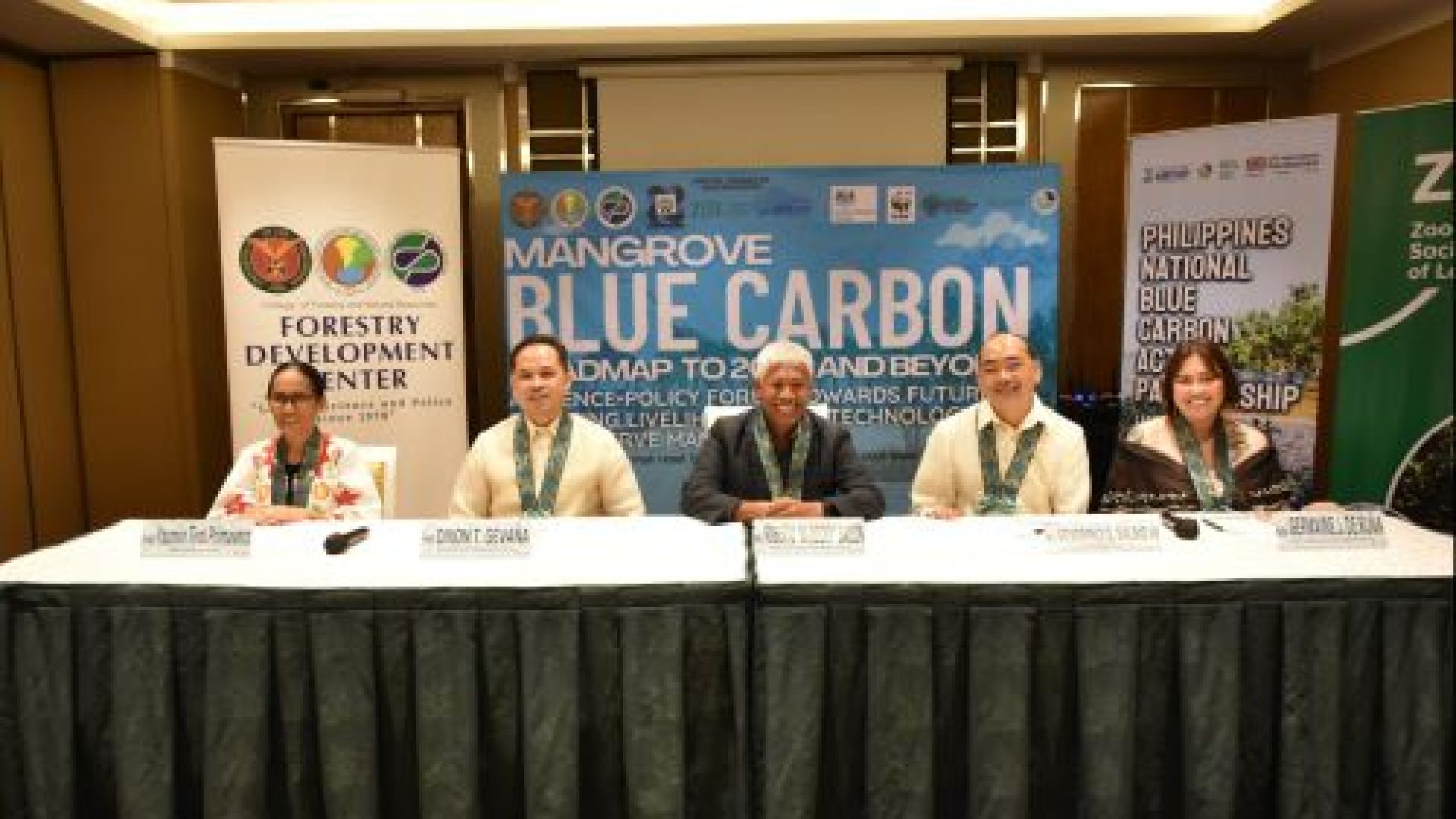The Forestry Development Center (FDC) of the University of the Philippines Los Baños and Department of Science and Technology – Philippine Council for Agriculture, Aquatic and Natural Resources Research and Development (DOST-PCAARRD), recently convened the Mangrove Blue Carbon Roadmap to 2030 and Beyond Forum at the Century Park Hotel, Manila. Supported by the Zoological Society of London Philippines (ZSL-Philippines), the Philippines National Blue Carbon Action Partnership (NBCAP), the British Embassy Manila, the World Wide Fund for Nature Philippines (WWF-Philippines), the Global Mangrove Alliance, and KLIMA, the forum united leaders, scientists, and communities in a multi-sectoral effort to shape policies, technologies, and livelihoods that will drive sustainable mangrove management and strengthen coastal resilience.
During the Mangrove Blue Carbon Roadmap to 2030 and Beyond press conference, experts outlined key challenges and solutions guiding the development of the National Blue Carbon Action Roadmap. (From left: Dr. Yasmin Primavera-Tirol, Dean, College of Fisheries and Marine Science, Aklan State University; Dr. Dixon Gevaña, Director, UPLB FDC; Roberto “Ka DoDoy” Ballon Chairman, KGMC, Kabasalan, Zamboanga Sibugay; Dr. Severino Salmo II, Professor and University Scientist, UP Diliman; and, Germaine De Ruña, Project Manager and Communications and Engagement Specialist, National Blue Carbon Action Partnership, ZSL Philippines.) Photo from DOST-PCAARD.
Central to the roadmap discussion was the push for policy and legislative priorities, including strong backing for the proposed Integrated Coastal Management (ICM) Act and the Coastal Greenbelt Bill, both aiming to institutionalize science-based and community-led approaches to managing the Philippines’ extensive coastlines. The forum also highlighted the need for coherent governance, cross-agency coordination, and inclusive mechanisms that empower local stakeholders as stewards of mangrove landscapes.
During the “Mangrove Blue Carbon Roadmap to 2030 and Beyond” forum at Century Park Hotel, Manila, Dr. Dixon Gevaña, Director, UPLB FDC, presented the roadmap’s key milestones, addressing critical environmental challenges and outlining solutions that support the protection and restoration of mangroves in the country. Photo from UPLB FDC.
“We are now on the frontlines of the global mangrove conservation agenda,” said Dr. Dixon T. Gevaña, Director of the UPLB Forestry Development Center. “Through this forum, we are creating a space where researchers, policy makers, and local communities can align priorities and translate valuable research and insights into evidence-based and actionable policies that can guide us into a climate-resilient nation.”
Key speakers at the forum signed a joint statement of support to strengthen blue carbon initiatives. Among them was Roberto “Ka Dodoy” Ballon, Chairman of KGMC in Kabasalan, Zamboanga Sibugay, who represented coastal communities. Photo from DOST-PCAARD.
The Philippines is among the countries most affected by mangrove loss, with 62% of mangrove cover left from its once lush 500,000 ha during the early 1900s. According to Dr. Yasmin Tirol, Dean, College of Fisheries and Marine Science, Aklan State University, this loss goes beyond ecosystems; it directly threatens food security, livelihoods, and even cultural identity in coastal communities that depend on gleaned mangrove resources for daily sustenance. Without mangroves, many families lose access to what she described as “food you don’t have to buy if you have something to glean,” highlighting the urgent need to conserve and restore mangroves for climate resilience and social and economic survival.
With over 60% of Filipinos living in low-lying areas vulnerable to climate risks, the Mangrove Blue Carbon Roadmap to 2030 forum emphasized the urgency of prioritizing mangroves in national adaptation and mitigation strategies—particularly by integrating blue carbon into the Philippines’ Nationally Determined Contributions (NDCs) under the Paris Agreement. Dr. Severino Salmo, Professor and University Scientist at UP Diliman, emphasized that achieving these targets requires a balanced approach—conserving mangroves for carbon permanence while restoring them for measurable additionality. This must be supported by standardized, site-specific data to strengthen carbon accounting and attract investment in blue carbon initiatives.
The recent Mangrove Blue Carbon Roadmap to 2030 and Beyond Forum held at Century Park Hotel, Manila, convened scientists, civil service organizations, community leaders, and public sector representatives to underscore the urgent need for science-based, community-led, and policy-backed approaches to protect and restore our mangrove ecosystems. Photo from UPLB FDC.
The forum also underscored that mangroves are vital to the lives and livelihoods of coastal communities. As Roberto “Ka Dodoy” Ballon, Chairman of KGMC in Kabasalan, Zamboanga Sibugay, stressed: “Kung aalisin mo kami sa aming kabuhayan, malayo kami sa dagat, sa ilog, sa mga mangrove—wala na kaming buhay. Ang panawagan namin: huwag kaming ilayo. Palakasin ang proteksyon—lalo na ang mangroves—dahil nandiyan ang aming kabuhayan, ang aming pamilya, at ang aming kinabukasan.” His message captured what the roadmap ultimately seeks to protect: kabuhayan, buhay, at kinabukasan.
Discussions at the forum covered harmonizing conservation with livelihoods, scaling blue carbon investments, and mainstreaming it into research and extension— highlighted by successful, community-led efforts that underscore the importance of inclusive local governance.
“Protecting mangroves is about securing food systems, livelihoods, and climate resilience for millions of Filipinos,” added Germaine De Ruña, Project Manager and Communications and Engagement Specialist at NBCAP-ZSL Philippines.
During the forum, Mariglo Rosaida I. Laririt, Assistant Director, Department of Environment and Natural Resources – Biodiversity Management Bureau, reiterated the government’s support in working with businesses, communities and civil society organizations to restore, conserve and sustainably manage coastal ecosystems. Photo from DOST-PCAARD.
As climate threats grow, mangrove protection has become a national priority—requiring cross-sector collaboration, community empowerment, and inclusive support to integrate blue carbon into policy and protect lives, livelihoods, and long-term resilience.




